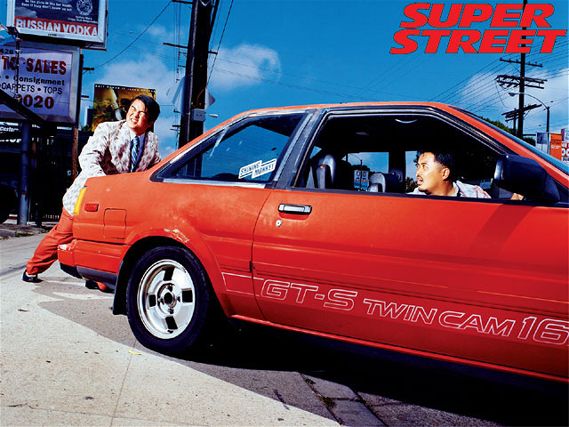 | Project Pinoy Pride Ae86 - 1985 Toyota Corolla GTS Coupe
| Project Pinoy Pride Ae86 - 1985 Toyota Corolla GTS Coupe
It was approximately a year ago when I bought my faded cherry red 1985 Toyota Corolla GTS Coupe. It cost me $1,000, a pack of smokes, and five minutes in the shower with a dude named Rusty-a deal I couldn't possibly pass up. It was also around the same time I had enough gall to introduce it as my project car in the October 2004 issue ("Seal the Deal", page 90), as if I was going to start building it up within those following months. Now fast forward to this issue and, as you can see from the subtitle above, that proposed buildup is only starting now.
So when you stop shaking your head in utter disappointment, allow me to introduce this long overdue project before it gets knocked back to a later issue. The first thing I did when I finally decided to start this project was to take it to Toysport, famous for tuning the finest Toyotas since 1985. They took out the stock 4AGE (bluetop) engine, which had a severe rod knock, and chucked it out among the thousands of engines sitting behind their shop, one of which will be the 20-valve 4AGE (silvertop) that will replace the original motor (see Part II next month). I then towed the engine-less Corolla to the world-famous P.J. Bonifacio Auto Design, along with a Vertex Trueno kit and cans of House of Kolor Cobalt Blue paint. Needless to say, the gang at P.J. Bonifacio Auto Design straightened out the AE86 chassis, installed the sweet Vertex Trueno kit, and lathered the car with Cobalt Blue.
Done deal, right? No, of course not, because this is where you should start taking notes. The team at P.J. Bonifacio Auto Design was elated when I brought over some quality stuff; more specifically, when they saw the genuine Vertex Trueno body kit, they knew fitting it to the chassis would be effortless while painting it would be trouble-free, which is why we need to talk about the importance of authenticity.
For you to understand why original body kits are better, let's take an inside look at the body kit industry. Body kits are mass produced through one mold. A company places fiberglass into this mold, generating body kit after body kit. However, when a company uses the same mold over and over again, its products start losing quality. At Vertex and other high-quality body kit companies, they only use the mold nine to 10 times before they get rid of it. This guarantees more premium body kits, and this is one of the reasons why body kits of this nature are more expensive.
Quality is also gained by how the fiberglass and resin is laid into the mold. In original body kits like the Vertex Trueno kit, the fiberglass is hand laid onto the mold of the kit to ensure even distribution and to make use of less material. This allows the body kit to be more flexible, making it more durable, especially during minor impacts. In replicas, however, the fiberglass is chopper gunned into the mold, creating a disproportion of material throughout the kit while making the kit heavier. This leads to cracking and malfunctions. One way to tell your body kit uses low-cost fiberglass is the fish-eye effect, which is revealed by seeing little pinholes throughout the kit.
One other aspect of the process is the laying of the resin, which is the hardener. Vertex rolls its resin for even distribution, allowing the kit to be lighter and stronger. With inexpensive kits, the resin is again chopper sprayed which usually applies excessive resin that makes the kit heavier. A body kit is less likely to break when it's lighter.
When P.J. Bonifacio and his crew installed the Vertex Trueno kit, they had no problems putting it on the chassis because there are pre-drilled holes at the factory locations on each bumper, allowing for easy plug and play. Vertex guarantees the fitment of each body kit, which is thoroughly inspected in Japan. A good majority of the replica kits don't come with pre-drilled holes, making the fitment imprecise and compromising the look of the vehicle. When a body kit is installed, the headlight and taillight's lines should match up with the bumper, while the fender should also match up with the wheel well. Last, the Vertex Trueno kit is gel coated and already primered, so the folks at P.J. Bonifacio have an easier time painting the kit.
Fine Details
When it comes to body kits, there is more than meets the eye. Take a closer look at the sexy House of Kolor paint and Vertex Trueno body kit:
The JDM turn lights are empty now until our own Tetsuya Ogushi ships some over.
The rear bumper is designed to reduce drag, and it retains the factory tow hooks.
The side skirts perfectly match the AE86's chassis. And notice how the side skirts line up evenly with the door.
Side ducts are used to air out oil coolers and for optional brake ducting. Note: Don't mind the mismatched hood. Roel was too lazy to close it plus the hood latch was broken.
Out with the old. in with the new.
The enlarged lower opening increases airflow to the radiator and intercooler.
Vertex kits come with a certificate of authentication and serial numbers to let consumers know it's the real deal.
